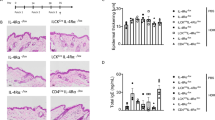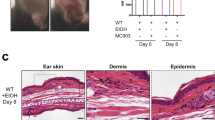Abstract
Topical application of biologically active vitamin D [1,25-dihydroxyvitamin D (1,25(OH)2D)], or low-calcemic analogues, curb skin inflammation through mechanisms that involve migratory dendritic cells (DCs) and regulatory T (TReg) cells. 1,25(OH)2D also promotes immunoregulation by mast cells, and inhibits the development of T helper type-9 (Th9) cells that secrete interleukin-9 (IL-9). Here, we investigated the ability of topical 1,25(OH)2D to suppress contact dermatitis through an IL-9-dependent process, examining mast cells and IL-9-secreting T cells. Contact dermatitis was modelled in adult BALB/c female mice by initiating a “biphasic ear swelling response” following a single application of 2,4-dinitrofluorobenzene (DNFB). Topical 1,25(OH)2D (125 ng) applied to ear pinnae prior to (but not after) DNFB sensitisation suppressed the efferent phase of the ear swelling response. This dose of 1,25(OH)2D did not cause hypercalcemia. At the peak of the efferent ear swelling response, proportions of TReg (CD3 + Foxp3+) cells and numbers of mast cells were increased in ear skin of 1,25(OH)2D-treated mice. Topical 1,25(OH)2D increased the proportion of Foxp3 + IL-9 + TReg cells and the capacity of TReg cells to secrete IL-9 ex vivo. However, the proportion of the IL-9 + cells of the total TReg cell population was small (< 1%), and the amount of IL-9 secreted by TReg cells from mice treated with IL-9 was low (< 50 pg/ml). Furthermore, injection of anti-IL-9 neutralising antibody (100 µg, intraperitoneally) prior to sensitisation did not significantly reverse the suppressive effects of 1,25(OH)2D. In conclusion, topically applied 1,25(OH)2D suppressed the efferent phase of a biphasic cutaneous ear swelling response through mechanism(s) that may be dependent on mast cells and TReg cells; however, the role of IL-9 in mediating these responses is uncertain. More studies are needed to further characterise the mechanisms by which topical 1,25(OH)2D modulates cell-mediated immune responses central to its suppressive effects upon contact dermatitis.




Similar content being viewed by others
Abbreviations
- 1,25(OH)2D:
-
1,25-dihydroxyvitamin D
- DNFB:
-
2,4-dinitrofluorobenzene
- DCs:
-
Dendritic cells
- EDLN or SDLN:
-
(Ear) or (skin)-draining lymph nodes
- IL-9, IL-10:
-
Interleukin-9 or -10
- Th9 cells:
-
T helper type-9 cells
- TReg cells:
-
Regulatory T cells
References
Blankenhaus B, Reitz M, Brenz Y, Eschbach ML, Hartmann W, Haben I, Sparwasser T, Huehn J, Kuhl A, Feyerabend TB, Rodewald HR, Breloer M (2014) Foxp3(+) regulatory T cells delay expulsion of intestinal nematodes by suppression of IL-9-driven mast cell activation in BALB/c but not in C57BL/6 mice. PLoS Pathog 10:e1003913. https://doi.org/10.1371/journal.ppat.1003913
Chen CY, Lee JB, Liu B, Ohta S, Wang PY, Kartashov AV, Mugge L, Abonia JP, Barski A, Izuhara K, Rothenberg ME, Finkelman FD, Hogan SP, Wang YH (2015) Induction of interleukin-9-producing mucosal mast cells promotes susceptibility to IgE-mediated experimental food allergy. Immunity 43:788–802. https://doi.org/10.1016/j.immuni.2015.08.020
de Kleer I, Vercoulen Y, Klein M, Meerding J, Albani S, van der Zee R, Sawitzki B, Hamann A, Kuis W, Prakken B (2010) CD30 discriminates heat shock protein 60-induced FOXP3 + CD4 + T cells with a regulatory phenotype. J Immunol 185:2071–2079. https://doi.org/10.4049/jimmunol.0901901
Devaux S, Castela A, Archier E, Gallini A, Joly P, Misery L, Aractingi S, Aubin F, Bachelez H, Cribier B, Jullien D, Le Maitre M, Richard MA, Ortonne JP, Paul C (2012) Topical vitamin D analogues alone or in association with topical steroids for psoriasis: a systematic review. J Eur Acad Dermatol Venereol 26(Suppl 3):52–60. https://doi.org/10.1111/j.1468-3083.2012.04524.x
Ding Y, Liao W, He XJ, **ang W (2017) Effects of 1,25(OH)2 D3 and vitamin D receptor on peripheral CD4+ /CD8 + double-positive T lymphocytes in a mouse model of systemic lupus erythematosus. J Cell Mol Med 21:975–985. https://doi.org/10.1111/jcmm.13037
Dudeck A, Dudeck J, Scholten J, Petzold A, Surianarayanan S, Kohler A, Peschke K, Vohringer D, Waskow C, Krieg T, Muller W, Waisman A, Hartmann K, Gunzer M, Roers A (2011) Mast cells are key promoters of contact allergy that mediate the adjuvant effects of haptens. Immunity 34:973–984. https://doi.org/10.1016/j.immuni.2011.03.028
Dyring-Andersen B, Bonefeld CM, Bzorek M, Lovendorf MB, Lauritsen JP, Skov L, Geisler C (2015) The vitamin D analogue calcipotriol reduces the frequency of CD8 + IL-17 + T cells in psoriasis lesions. Scand J Immunol 82:84–91. https://doi.org/10.1111/sji.12304
Ghoreishi M, Bach P, Obst J, Komba M, Fleet JC, Dutz JP (2009) Expansion of antigen-specific regulatory T cells with the topical vitamin d analog calcipotriol. J Immunol 182:6071–6078. https://doi.org/10.4049/jimmunol.0804064
Gorman S, Judge MA, Burchell JT, Turner DJ, Hart PH (2010) 1,25-dihydroxyvitamin D3 enhances the ability of transferred CD4 + CD25 + cells to modulate T helper type 2-driven asthmatic responses. Immunology 130:181–192. https://doi.org/10.1111/j.1365-2567.2009.03222.x
Gorman S, Judge MA, Hart PH (2010) Gene regulation by 1,25-dihydroxyvitamin D3 in CD4 + CD25 + cells is enabled by IL-2. J Invest Dermatol 130:2368–2376. https://doi.org/10.1038/jid.2010.167
Gorman S, Judge MA, Hart PH (2010) Topical 1,25-dihydroxyvitamin D3 subverts the priming ability of draining lymph node dendritic cells. Immunology 131:415–425. https://doi.org/10.1111/j.1365-2567.2010.03315.x
Gorman S, Kuritzky LA, Judge MA, Dixon KM, McGlade JP, Mason RS, Finlay-Jones JJ, Hart PH (2007) Topically applied 1,25-dihydroxyvitamin D3 enhances the suppressive activity of CD4 + CD25 + cells in the draining lymph nodes. J Immunol 179:6273–6283
Grimbaldeston MA, Nakae S, Kalesnikoff J, Tsai M, Galli SJ (2007) Mast cell-derived interleukin 10 limits skin pathology in contact dermatitis and chronic irradiation with ultraviolet B. Nat Immunol 8:1095–1104. https://doi.org/10.1038/ni1503
Guo Z, Okamoto H, Imamura S (1992) The effect of 1,25(OH)2-vitamin D3 on Langerhans cells and contact hypersensitivity in mice. Arch Dermatol Res 284:368–370
Himmel ME, Crome SQ, Ivison S, Piccirillo C, Steiner TS, Levings MK (2011) Human CD4 + FOXP3 + regulatory T cells produce CXCL8 and recruit neutrophils. Eur J Immunol 41:306–312. https://doi.org/10.1002/eji.201040459
Honda T, Egawa G, Grabbe S, Kabashima K (2013) Update of immune events in the murine contact hypersensitivity model: toward the understanding of allergic contact dermatitis. J Invest Dermatol 133:303–315. https://doi.org/10.1038/jid.2012.284
Jones TG, Hallgren J, Humbles A, Burwell T, Finkelman FD, Alcaide P, Austen KF, Gurish MF (2009) Antigen-induced increases in pulmonary mast cell progenitor numbers depend on IL-9 and CD1d-restricted NKT cells. J Immunol 183:5251–5260. https://doi.org/10.4049/jimmunol.0901471
Kaplan MH, Hufford MM, Olson MR (2015) The development and in vivo function of T helper 9 cells. Nat Rev Immunol 15:295–307. https://doi.org/10.1038/nri3824
Katayama I, Minatohara K, Yokozeki H, Nishioka K (1996) Topical vitamin D3 downregulates IgE-mediated murine biphasic cutaneous reactions. Int Arch Allergy Immunol 111:71–76
Keating P, Munim A, Hartmann JX (2014) Effect of vitamin D on T-helper type 9 polarized human memory cells in chronic persistent asthma. Ann Allergy Asthma Immunol 112:154–162. https://doi.org/10.1016/j.anai.2013.11.015
Kivelevitch DN, Hebeler KR, Patel M, Menter A (2013) Emerging topical treatments for psoriasis. Expert Opin Emerg Drugs 18:523–532. https://doi.org/10.1517/14728214.2013.861418
Lipinska-Opalka A, Wawrzyniak A, Lewicki S, Zdanowski R, Kalicki B (2017) Evaluation of immune indices and serum vitamin D content in children with atopic dermatitis. Adv Exp Med Biol 1020:81–89. https://doi.org/10.1007/5584_2017_20
Lu LF, Lind EF, Gondek DC, Bennett KA, Gleeson MW, Pino-Lagos K, Scott ZA, Coyle AJ, Reed JL, Van Snick J, Strom TB, Zheng XX, Noelle RJ (2006) Mast cells are essential intermediaries in regulatory T-cell tolerance. Nature 442:997–1002. https://doi.org/10.1038/nature05010
McGlade JP, Gorman S, Zosky GR, Larcombe AN, Sly PD, Finlay-Jones JJ, Turner DJ, Hart PH (2007) Suppression of the asthmatic phenotype by ultraviolet B-induced, antigen-specific regulatory cells. Clin Exp Allergy 37:1267–1276. https://doi.org/10.1111/j.1365-2222.2007.02750.x
Muehleisen B, Gallo RL (2013) Vitamin D in allergic disease: shedding light on a complex problem. J Allergy Clin Immunol 131:324–329. https://doi.org/10.1016/j.jaci.2012.12.1562
Noelle RJ, Nowak EC (2010) Cellular sources and immune functions of interleukin-9. Nat Rev Immunol 10:683–687. https://doi.org/10.1038/nri2848
Ooi JH, Chen J, Cantorna MT (2012) Vitamin D regulation of immune function in the gut: why do T cells have vitamin D receptors? Mol Aspects Med 33:77–82. https://doi.org/10.1016/j.mam.2011.10.014
Palmer MT, Lee YK, Maynard CL, Oliver JR, Bikle DD, Jetten AM, Weaver CT (2011) Lineage-specific effects of 1,25-dihydroxyvitamin D(3) on the development of effector CD4 T cells. J Biol Chem 286:997–1004. https://doi.org/10.1074/jbc.M110.163790
Rauber S, Luber M, Weber S, Maul L, Soare A, Wohlfahrt T, Lin NY, Dietel K, Bozec A, Herrmann M, Kaplan MH, Weigmann B, Zaiss MM, Fearon U, Veale DJ, Canete JD, Distler O, Rivellese F, Pitzalis C, Neurath MF, McKenzie ANJ, Wirtz S, Schett G, Distler JHW, Ramming A (2017) Resolution of inflammation by interleukin-9-producing type 2 innate lymphoid cells. Nat Med 23:938–944. https://doi.org/10.1038/nm.4373
Saint-Mezard P, Krasteva M, Chavagnac C, Bosset S, Akiba H, Kehren J, Kanitakis J, Kaiserlian D, Nicolas JF, Berard F (2003) Afferent and efferent phases of allergic contact dermatitis (ACD) can be induced after a single skin contact with haptens: evidence using a mouse model of primary ACD. J Invest Dermatol 120:641–647. https://doi.org/10.1046/j.1523-1747.2003.12093.x
Sarkar S, Hewison M, Studzinski GP, Li YC, Kalia V (2016) Role of vitamin D in cytotoxic T lymphocyte immunity to pathogens and cancer. Crit Rev Clin Lab Sci 53:132–145. https://doi.org/10.3109/10408363.2015.1094443
Schwarz A, Navid F, Sparwasser T, Clausen BE, Schwarz T (2012) 1,25-dihydroxyvitamin D exerts similar immunosuppressive effects as UVR but is dispensable for local UVR-induced immunosuppression. J Invest Dermatol 132:2762–2769. https://doi.org/10.1038/jid.2012.238
Sehra S, Yao W, Nguyen ET, Glosson-Byers NL, Akhtar N, Zhou B, Kaplan MH (2015) TH9 cells are required for tissue mast cell accumulation during allergic inflammation. Journal Allergy Clin Immunol 136:433–440 e431. https://doi.org/10.1016/j.jaci.2015.01.021
van der Aar AM, Sibiryak DS, Bakdash G, van Capel TM, van der Kleij HP, Opstelten DJ, Teunissen MB, Kapsenberg ML, de Jong EC (2011) Vitamin D3 targets epidermal and dermal dendritic cells for induction of distinct regulatory T cells. J Allergy Clin Immunol 127:1532–1540 e1537. https://doi.org/10.1016/j.jaci.2011.01.068
Wang HW, Tedla N, Lloyd AR, Wakefield D, McNeil PH (1998) Mast cell activation and migration to lymph nodes during induction of an immune response in mice. J Clin Investigation 102:1617–1626. https://doi.org/10.1172/JCI3704
Yip KH, Kolesnikoff N, Yu C, Hauschild N, Taing H, Biggs L, Goltzman D, Gregory PA, Anderson PH, Samuel MS, Galli SJ, Lopez AF, Grimbaldeston MA (2014) Mechanisms of vitamin D(3) metabolite repression of IgE-dependent mast cell activation. J Allergy Clin Immunol 133:1356–1364, e1351–1314. https://doi.org/10.1016/j.jaci.2013.11.030
Zeiser R, Nguyen VH, Hou JZ, Beilhack A, Zambricki E, Buess M, Contag CH, Negrin RS (2007) Early CD30 signaling is critical for adoptively transferred CD4 + CD25 + regulatory T cells in prevention of acute graft-versus-host disease. Blood 109:2225–2233. https://doi.org/10.1182/blood-2006-07-038455
Acknowledgements
We thank Ms Maxine Crook (Princess Margaret Hospital Pathology; Subiaco, Western Australia) for the preparation and staining of tissue sections for histopathology assessment. This research was supported by: the BrightSpark Foundation; Telethon Kids Institute; University of Western Australia; the Health Department of Western Australia (to SG); and, an Australian National Health and Medical Research Council (NHMRC) Career Development Fellowship (to MAG, GNT626907). SG is currently funded by an Al & Val Rosenstrauss Fellowship from the Rebecca L Cooper Foundation.
Author information
Authors and Affiliations
Corresponding author
Ethics declarations
Conflict of interest
The authors declare no conflicts of interest.
Ethical approval
All applicable international, national, and/or institutional guidelines for the care and use of animals were followed. All procedures performed in studies involving animals were in accordance with the ethical standards of Telethon Kids Institute at which the studies were conducted. All experiments were performed according to the ethical guidelines of the National Health and Medical Research Council of Australia and with approval from the Telethon Kids Institute Animal Ethics Committee (AEC#229).
Rights and permissions
About this article
Cite this article
Gorman, S., Geldenhuys, S., Weeden, C.E. et al. Investigating the roles of regulatory T cells, mast cells and interleukin-9 in the control of skin inflammation by vitamin D. Arch Dermatol Res 310, 221–230 (2018). https://doi.org/10.1007/s00403-018-1814-z
Received:
Revised:
Accepted:
Published:
Issue Date:
DOI: https://doi.org/10.1007/s00403-018-1814-z




